The Voice of the Customer (VoC) refers to the process of capturing customer feedback, opinions, needs, and expectations to better understand and improve products, services, and overall customer experience.
As businesses increasingly prioritize customer experience management over factors like price and product quality, VoC has emerged as a critical tool for staying competitive.
The methodology involves gathering both direct and indirect feedback to help businesses innovate and meet customer demands, ensuring long-term success.
Table of contents
- What is Voice of Customer?
- Key Elements of VoC Research
- How to Conduct Effective VoC Research?
- How to Ask the Right Questions in VoC Programs?
- Methods to Collect Voice of the Customer Data
- How Companies Use Voice of the Customer?
- How to Get Started with a VoC Program?
- Benefits of VoC Research
- Final Words
- Related Articles
What is Voice of Customer?
Voice of Customer (VoC) refers to a systematic method used by businesses to capture customer feedback and understand their needs, wants, and pain points.
This process plays a crucial role in product development, marketing strategy, and overall business growth, as it allows companies to align their products and services with customer expectations.
The primary goal of VoC research is to gain a deep understanding of customer needs, enabling companies to develop products and services that resonate with their audience.
By listening to what customers have to say, businesses can better design products, create more effective marketing campaigns, and ultimately increase customer satisfaction and loyalty.
Key Elements of VoC Research
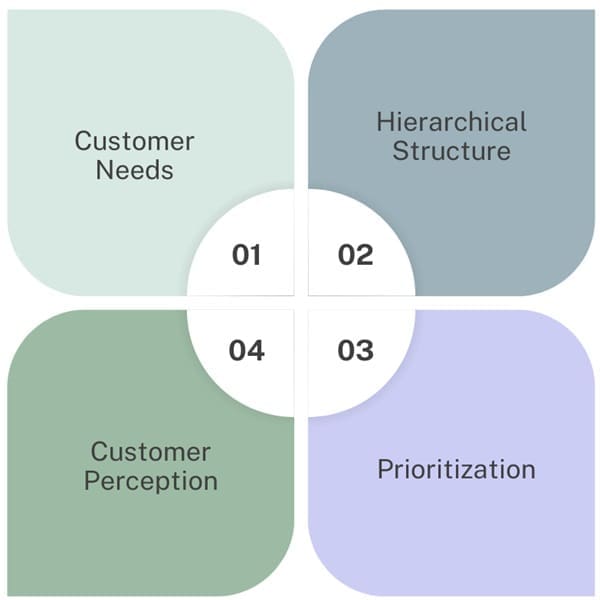
A successful VoC research process includes several key elements, which ensure that the insights gathered are accurate, unbiased, and actionable.
- Customer Needs: VoC research focuses on understanding the specific needs and pain points of customers. This requires businesses to listen to customer feedback, identify common themes, and prioritize their most pressing concerns.
- Hierarchical Structure: Organize the information gathered through VoC research into a hierarchical structure. This structure categorizes customer needs based on their importance. By doing so, it becomes easier to identify which needs should be addressed first in product development or marketing.
- Prioritization: Not all customer needs carry equal weight. VoC research helps businesses determine which needs are most critical to their customers and which can be addressed later. This prioritization ensures that businesses focus their resources on solving the most impactful problems.
- Customer Perception: In addition to identifying customer needs, VoC research also involves understanding how customers perceive a company’s products and services. This insight helps businesses determine where improvements are necessary and how they can enhance customer satisfaction.
Types of VoC Research
There are two primary types of VoC research: qualitative and quantitative.
- Qualitative research involves gathering detailed, open-ended feedback from customers. You can conduct interviews, focus groups, or surveys to gather customer feedback. Encourage customers to share their thoughts and experiences in their own words. Qualitative research provides deep insights into customer emotions, motivations, and perceptions, helping businesses understand the “why” behind customer behaviour.
- Quantitative research involves collecting structured, numerical data from a larger group of customers. Businesses can use surveys, polls, or other data collection methods to quantify customer opinions and preferences. Quantitative research helps them identify patterns and trends in customer feedback. This research provides actionable data that businesses can use to make informed decisions.
Why is the Voice of the Customer Important?
In today’s digital landscape, customers have numerous ways to compare products and services, making it vital for businesses to understand customer preferences. A robust VoC program allows companies to:
- Understand customer priorities: What do customers value the most? What are their pain points? Without this knowledge, it’s impossible to cater to their needs.
- Improve customer retention: Listening to customer feedback helps businesses retain customers, as they feel heard and valued.
- Gain a competitive edge: Companies that prioritize customer experience can outperform competitors by understanding customer desires and acting on them.
Statistics show that companies using a VoC program can experience:
- 61% higher customer satisfaction (NPS score)
- 55% improved customer retention
- 4-8% revenue growth compared to competitors
Key Components of a VoC Program
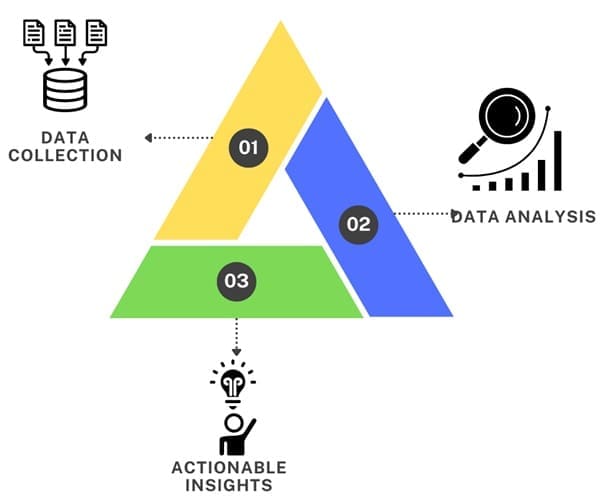
A successful VoC program revolves around three main components:
- Data collection: Gathering feedback from multiple sources.
- Data analysis: Understanding the insights and trends behind the data.
- Actionable insights: Taking action based on feedback to improve customer experience.
Areas where VoC Guides Business Decisions
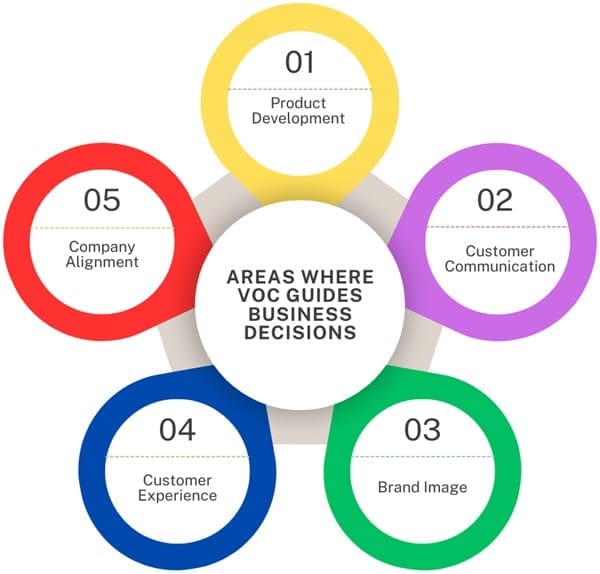
VoC impacts various aspects of a business, helping organizations evolve and meet customer expectations. Here are some critical areas where VoC insights play a role:
- Product Development: VoC enables businesses to understand how intuitive their products are and identify additional features that customers might desire. Through continuous feedback, businesses can test and launch new products or features confidently, knowing they meet customer needs.
- Customer Communication: Using VoC insights, companies can incorporate customer language into their marketing efforts. By using customers’ words in promotional content, businesses can create more relatable and engaging messaging. This can also build trust by highlighting customer testimonials on websites or social media.
- Brand Image: Monitoring customer feedback helps businesses understand how their brand is perceived compared to competitors. Analytics can also provide insights into customer behavior and trends, guiding decisions about how to position the brand moving forward.
- Customer Experience: VoC is essential in identifying gaps in the customer journey, whether in customer service, onboarding, or overall engagement. Customers are more likely to return to a business that listens to them and takes action to improve their experience.
- Company Alignment: A centralized VoC program fosters collaboration across departments, ensuring that every part of the company is working toward shared goals around customer experience. With all teams accessing the same insights and reports, businesses can align their strategies effectively.
How to Conduct Effective VoC Research?

Here are some key steps to guide the process:
- Define Your Objectives: Before starting VoC research, businesses must clearly define their objectives. What do they want to learn from their customers? Are they trying to improve a specific product, refine their marketing message, or understand customer satisfaction levels? Having a clear goal in mind will help guide the research process.
- Identify the Right Customer Segments: Businesses should identify their target audience and ensure they are speaking with customers who represent the larger market. This might include current customers, potential customers, and even experts in the field who have valuable insights into customer behaviour.
- Design the Research Methodology: Businesses should decide on the best research methodology for gathering customer feedback. This could involve a mix of qualitative and quantitative research, depending on the type of insights they want to gather. For example, interviews might be used to explore customer emotions and motivations, while surveys could be used to gather numerical data on customer preferences.
- Avoid Bias: One of the biggest challenges in VoC research is avoiding bias. Businesses must ensure that the questions they ask are neutral and not leading and that they are gathering feedback from a diverse group of customers. This helps ensure that the insights gathered are accurate and reflective of the broader market.
- Analyze and Prioritize Insights: After collecting the data, businesses should analyze the feedback to identify common themes and trends. They must categorize customer needs and prioritize them based on their importance. Then, they should pinpoint areas where improvements can be made.
- Ensure Actionable Insights: The ultimate goal of VoC research is to provide actionable insights that can guide business decisions. Businesses should focus on identifying specific areas for improvement and creating a plan for how they will address customer needs.
How to Ask the Right Questions in VoC Programs?
To fully understand customer sentiment, it’s crucial to ask the right questions. Some basic VoC questions include:
- What do customers love about your company?
- What aspects need improvement?
- What are customers missing from their experience?
- Is anything confusing about the interaction?
These questions provide a foundation, but they can be customized based on the business area under investigation, such as brand awareness, product reception, or customer satisfaction. For instance, a hotel could use these questions to gather insights throughout the guest’s journey:
- Pre-arrival: Asking about preferences, allergies, or any other information that can personalize the stay.
- During the stay: Offering upsells or resolving issues immediately to prevent negative reviews.
- Post-stay: Gathering feedback on all aspects of the guest’s experience, from cleanliness to customer service.
Methods to Collect Voice of the Customer Data
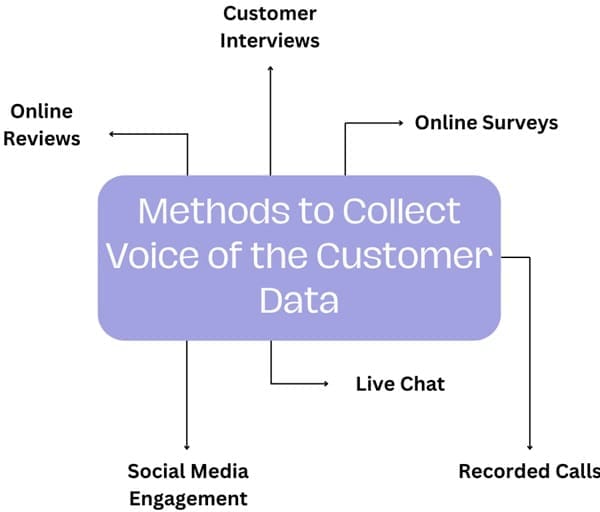
VoC data can be collected through various methods, depending on the nature of the business and the specific insights needed. Some of the most popular methods include:
- Customer Interviews: These provide qualitative insights by engaging directly with customers. Interviews allow businesses to ask open-ended questions, diving deep into customer preferences, pain points, and expectations.
- Online Surveys: Surveys are an effective way to collect large amounts of quantitative data quickly. Careful question design is essential to avoid bias and ensure reliable results.
- Recorded Calls: Using artificial intelligence (AI), companies can analyze recorded customer interactions from sales or support calls to extract valuable insights. AI can identify trends and patterns that might otherwise be missed.
- Live Chat: Real-time customer feedback can be gathered through live chat sessions. These not only help with sales but also provide valuable data on customer concerns and questions.
- Social Media Engagement: Social media platforms are a goldmine for customer feedback. Companies can listen to conversations, comments, and reviews to gauge customer sentiment and gather insights on both their own products and those of competitors.
- Online Reviews: Customers often view reviews as highly credible, making them a valuable source of VoC data. Positive reviews reveal what customers love, while negative reviews highlight areas needing improvement. Both types of reviews provide valuable insights.
Combining Methods for Greater Insight
While each VoC method has its strengths, businesses often use multiple methods together to get a more comprehensive view of customer feedback. This practice, known as triangulation, ensures that feedback is captured from several angles, making it more robust and reliable.
For example, a company might combine customer interviews with social media engagement and online reviews to gain a fuller understanding of customer opinions on a new product. By gathering data from different sources, the business can spot trends, identify gaps, and make informed decisions.
How Companies Use Voice of the Customer?
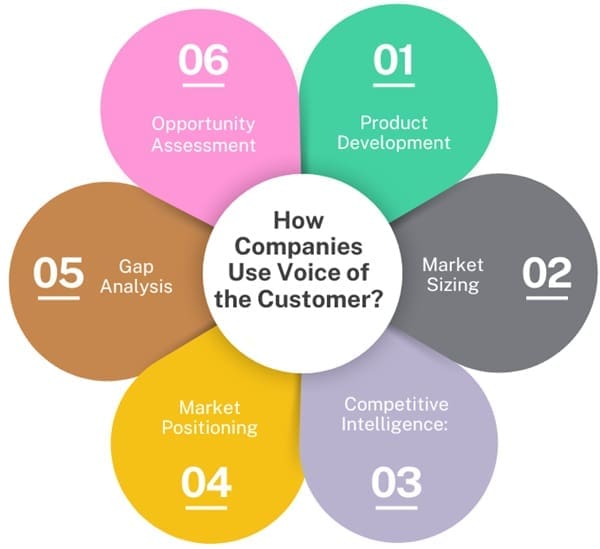
Businesses use VoC insights for a variety of purposes, each aimed at improving different aspects of their operations. Some of the most common use cases include:
- Product Development: VoC feedback helps businesses understand the features and benefits that matter most to customers, enabling them to prioritize product enhancements based on actual needs.
- Market Sizing: Customer insights can be used to size target markets or segments, ensuring that products are positioned for maximum profitability.
- Competitive Intelligence: By understanding how customers perceive competitors, businesses can identify opportunities to differentiate themselves and improve their competitive advantage.
- Market Positioning: VoC data helps businesses establish their brand’s position in the market. By understanding how customers view the brand, businesses can create strategies to maintain or improve their standing.
- Gap Analysis: VoC insights are crucial for identifying gaps between actual and potential performance. Customer feedback highlights areas for growth, whether it’s a product feature needing improvement or a service process that could be streamlined.
- Opportunity Assessment: VoC data helps businesses evaluate potential investments or initiatives. By understanding customer interest and demand, companies can make data-backed decisions about where to focus their resources.
How to Get Started with a VoC Program?
Implementing a VoC program involves several steps. First, businesses need to decide which VoC methods to use. This decision will depend on the type of insights they need and the resources available.
Once the methods are chosen, businesses should develop a plan for regularly collecting and analyzing feedback.
Here are a few tips to help get started:
- Identify key touchpoints: Identify key customer touchpoints where you can collect feedback, such as after a purchase or following a customer service interaction.
- Choose the right tools: Use VoC tools that automate feedback collection, such as customer surveys or social media monitoring tools.
- Make feedback actionable: Use the insights gathered from VoC data to drive meaningful improvements within the company. Ensure that these insights lead to tangible changes and enhancements. This means creating a plan for addressing customer concerns and communicating the changes back to customers.
Benefits of VoC Research
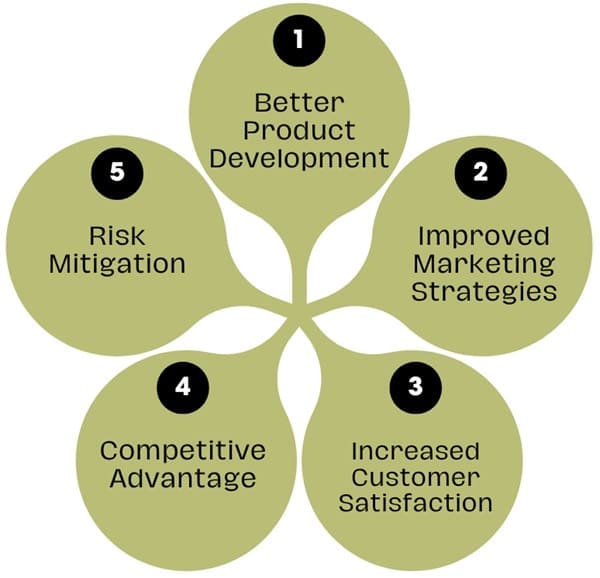
VoC research provides several benefits to businesses:
- Better Product Development: By understanding customer needs, businesses can develop products that are more aligned with market demands, reducing the risk of product failure.
- Improved Marketing Strategies: VoC research helps businesses create more targeted and effective marketing messages that resonate with their audience, leading to higher conversion rates.
- Increased Customer Satisfaction: By addressing customer pain points and delivering products that meet their needs, businesses can improve customer satisfaction and loyalty.
- Competitive Advantage: VoC research provides businesses with insights that can give them a competitive edge in the market. By understanding customer needs better than their competitors, businesses can develop innovative products that stand out.
- Risk Mitigation: VoC research helps businesses identify potential challenges and risks early in the product development process, allowing them to make adjustments before launching a product or service.
Final Words
The Voice of the Customer (VoC) is a powerful strategy that allows businesses to stay connected with their customers, understand their needs, and deliver products and services that exceed expectations. By implementing a comprehensive VoC program, businesses can improve customer satisfaction, reduce churn, and ultimately gain a competitive edge in their industry.
The key to success lies in collecting data, analyzing it effectively, and turning those insights into actionable steps that improve the customer experience.

About Six Sigma Development Solutions, Inc.
Six Sigma Development Solutions, Inc. offers onsite, public, and virtual Lean Six Sigma certification training. We are an Accredited Training Organization by the IASSC (International Association of Six Sigma Certification). We offer Lean Six Sigma Green Belt, Black Belt, and Yellow Belt, as well as LEAN certifications.
Book a Call and Let us know how we can help meet your training needs.



















